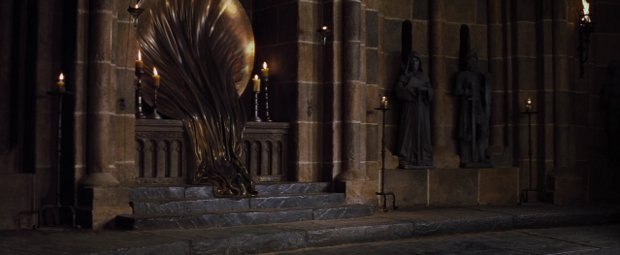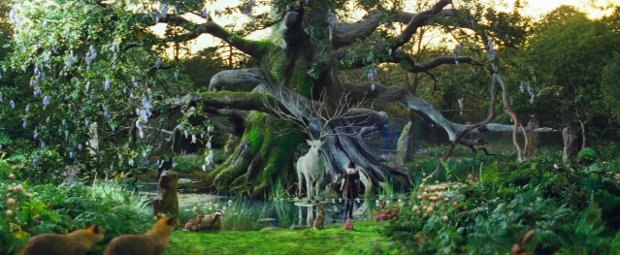Snow White gets a gritty makeover for her adventure with the Huntsman.

Tim Burton's Alice in Wonderland reinvigorated the fairy tale genre in live action, and producer Joe Roth has struck back with Snow White and the Huntsman, this time with newcomer Rupert Sanders as director. Sanders wanted a gritty yet fantastical take on Snow White. Culling from a number of influences besides the Brothers Grimm (including Lord of the Rings, Excalibur, Princess Mononoke), he's fashioned a sword and sorcery tone poem with Kristen Stewart's Snow White as Joan of Arc, Chris Hemsworth's Huntsman as a melancholy widower and Charlize Theron's evil Queen as a vain supermodel.
In fact, the film's visual motif is impermanence. Creatures and states of being are in a constant state of flux with lots of shattering and metamorphosis. The search for immortality is futile. Nearly a dozen VFX studios worked on the film, including Rhythm & Hues ( dwarves, the enchanted forest creatures, CG fairies, bridge troll, magpies and ravens); Double Negative (dark forest creatures); Pixomondo (the shadow army); The Mill (The Mirror Man); and Lola (the aging effects of the Queen).
In the opening battle performed by Pixomondo, the Queen's soldiers disintegrate on contact. It's a ploy to deceive the king but it's effective visually and thematically. " We went through a lot of iterations to get the obsidian look," explains co- visual effects supervisor Phil Brennan. "It needed to crumble in a solid way; it needed to be a believable kind of physics. Pixomondo used Houdini with some custom pieces."
Then there's the Mirror Man worked on by The Mill. "We didn't want the liquid metal look," Brennan continues. "We shot a whole bunch of high-speed stuff with liquids. From that we went into the simulation world and played with cloth and particle simulations and all sorts of things in between. Where we ended up was somewhere between liquid and cloth. It's an iconic character so we had to find a way to instill a certain amount of personality with little movement. We didn't want to take away from the elegance of it."
Sanders' inspiration for the Mirror Man was a sculpture called Face-Off by London-based Irish artist Kevin Francis Gray. It took six months of R&D to design the effect. As a launch pad for inspiration, the crew started with a live-action physical element shoot, upending buckets of paint on dummies at 1,000 fps to see what happens in the real world. As the effect evolved it became clear that cloth simulation was the look that was going to work the best. The Mill (under the VFX supervision of Nicolas Hernandez) used Maya, ncloth, Houdini, RealFlow and Nuke.
The dark forest was created by Double Negative (supervised by John Moffatt). According to co-visual effects supervisor Cedric Nicolas-Troyan, who's worked with the director for eight years, the idea was to conjure a charred look and nature gone awry but with a photographic reality shot in the Black Park Woods outside of Pinewood Studios in London. Aside from models of the twisted and distorted trees, an additional procedural system was developed in Maya to enable the rapid creation of multiple variations of photo-real branches which were then keyframe animated by animation supervisor Robyn Luckham's team for shots of the forest coming to life and grabbing for Snow White as she tries to escape. A patch of mushrooms eject clouds of hallucinogenic pollen (using DNeg's fluid solver dnSquirt) into her face.
The forest is also teeming with CG creatures, large and small, particularly Beetles. And the dark fairies are comprised of shards of obsidian torn down from the ceiling, which then form together into massive humanoid form. The solution involved a combination of Maya and Houdini. The simulations could be controlled with multiple parameters to enable detailed direction of the look and behavior of the shards and to allow complex actions like breaking apart and reforming.
Nicolas-Troyan also contributed crucial design work. "I designed the troll and the wood fairies in the enchanted forest," he says. "We wanted to go against the usual animal types. For example, the fairies are very childlike and, yes, the Stag is a definite nod to Miyazaki and the challenge was trying to come up with a graphic representation of Princess Mononoke in live-action."
Meanwhile his troll becomes a figure of compassion. "We were given a lot backstory from Cedric about how this creature evolved, what mechanisms it uses for hunting, and why it has developed into the creature that it is," remarks Rhythm & Hues' visual effects supervisor Todd Shifflett. "This troll was not an evil character; the whole real focus they were trying to maintain for the film was these are just animals in the forest, and they have to live just like anything else has to live, and it [the bridge troll] happens to feed on other animals, and we shouldn't just look upon that as evil, it's just how this thing has developed. So it just happens to be that its camouflage is well suited for the banks and riverbeds and happens to fit in well for these stone bridges that civilization is building, so that's how the bridge troll gravitated towards that sort of environment."
For the fairies, Rhythm & Hues worked with Nicolas-Troyan on the backstory: how they fly, how they communicate with one another, how they behave, even what they eat because we it affects how their teeth grow.
"We pushed for them to have some body hair on them: it adds a level of detail and texture to the characters," Shifflett continues. "They wanted some magical component in terms of their patterning, in other words, how they were able to blend into the forest in an interesting sort of animalistic pattern. We were able to use that body hair, to give subtle hair that gives you a pattern change you might see on a butterfly. They definitely have a pearlescent skin -- they're very small creatures, we wanted to get the sense that if you were in front of a bright light, you'd see some of their bones or internal structure. They wanted iridescence applied to the skin as well. It was a bit challenging because there wasn't enough time in the schedule to prepare that much animation. So we wound up using sections of mocap because we thought we'd be able to get more variations done more quickly."
As for the dwarfs, R&H attempted some cost-efficient 2D and 3D methods. "We went down some 3D paths, that we knew we probably wouldn't be using in the long run," Shifflett says, "but we wanted to find out what useful things are we going to learn going down this path? And so, in doing that, [digital supervisor] Harry [Lam] worked closely with the software department in developing our tools further, to have our 2D warp capability much more specialized so we could actually zero in on parts of the image, and have it non-uniformly warped while other parts of the image were locked and held down. So it was a lot of that R&D that gave a lot of knowledge to help Harry guide our software team because we're going to have to do this over and over again.
"And we chose to go with a 2D solution as opposed to a 3D rendered solution. Then, as the testing went on, we discovered that we can't go from a standing pose to a sitting pose. It became apparent that a lot of shots could be accomplished using traditional techniques."
Again, it was all about shifting gears and trying new combinations of techniques on Snow White and the Huntsman.
--
Bill Desowitz is former senior editor of AWN and VFXWorld. He's the owner of the Immersed in Movies blog (www.billdesowitz.com), a regular contributor to Thompson on Hollywood at Indiewire and author of James Bond Unmasked (www.jamesbondunmasked.com), which chronicles the 50-year evolution of 007 on screen and features interviews with all six actors.














